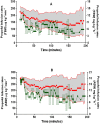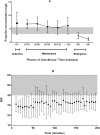Evaluation of propofol anesthesia in morbidly obese children and adolescents
- PMID: 23602008
- PMCID: PMC3644256
- DOI: 10.1186/1471-2253-13-8
Evaluation of propofol anesthesia in morbidly obese children and adolescents
Abstract
Background: Poor characterization of propofol pharmacokinetics and pharmacodynamics in the morbidly obese (MO) pediatric population poses dosing challenges. This study was conducted to evaluate propofol total intravenous anesthesia (TIVA) in this population.
Methods: After IRB approval, a prospective study was conducted in 20 MO children and adolescents undergoing laparoscopic surgery under clinically titrated propofol TIVA. Propofol doses/infusion rates, hemodynamic variables, times to induction and emergence, and postoperative occurrence of respiratory adverse events (RAE) were recorded, along with intraoperative blinded Bispectral Index/BIS and postoperative Ramsay sedation scores (RSS). Study subjects completed awareness questionnaires on postoperative days 1 and 3. Propofol concentrations were obtained at predetermined intra- and post-operative time points.
Results: Study subjects ranged 9 - 18 years (age) and 97 - 99.9% (BMI for age percentiles). Average percentage variability of hemodynamic parameters from baseline was ≈ 20%. Patients had consistently below target BIS values (BIS < 40 for >90% of maintenance phase), delayed emergence (25.8 ± 22 minutes), increased somnolence (RSS ≥ 4) in the first 30 minutes of recovery from anesthesia and 30% incidence of postoperative RAE, the odds for which increased by 14% per unit increase in BMI (p ≤ 0.05). Mean propofol concentration was 6.2 mg/L during maintenance and 1.8 mg/L during emergence from anesthesia.
Conclusions: Our findings indicate clinical overestimation of propofol requirements and highlight the challenges of clinically titrated propofol TIVA in MO adolescents. In this setting, it may be advantageous to titrate propofol to targeted BIS levels until more accurate weight-appropriate dosing regimens are developed, to minimize relative overdosing and its consequences.
Keywords: Adolescents; Anesthetic depth; Bariatric; Bispectral index; Morbidly obese; Pediatric; Propofol; Total intravenous anesthesia.
Figures




Similar articles
-
Population pharmacokinetic-pharmacodynamic modeling and dosing simulation of propofol maintenance anesthesia in severely obese adolescents.Paediatr Anaesth. 2015 Sep;25(9):911-923. doi: 10.1111/pan.12684. Epub 2015 May 13. Paediatr Anaesth. 2015. PMID: 25975390 Free PMC article.
-
A comparison of BIS recordings during propofol-based total intravenous anaesthesia and sevoflurane-based inhalational anaesthesia in obese patients.Anaesthesiol Intensive Ther. 2016;48(4):239-247. doi: 10.5603/AIT.2016.0044. Anaesthesiol Intensive Ther. 2016. PMID: 27797096
-
Maintenance of anesthesia in morbidly obese patients using propofol with continuous BIS-monitoring: a comparison of propofol-remifentanil and propofol-epidural anesthesia.Acta Anaesthesiol Belg. 2011;62(2):73-82. Acta Anaesthesiol Belg. 2011. PMID: 21919373
-
Bispectral index as a guide for titration of propofol during procedural sedation among children.Pediatrics. 2005 Jun;115(6):1666-74. doi: 10.1542/peds.2004-1979. Pediatrics. 2005. PMID: 15930231 Review.
-
[Total intravenous anesthesia. On the way to standard practice in pediatrics].Anaesthesist. 2003 Sep;52(9):763-77. doi: 10.1007/s00101-003-0560-5. Anaesthesist. 2003. PMID: 14504802 Review. German.
Cited by
-
Prescribing Patterns of Continuous Infusions in Nonobese versus Obese Children Admitted to the Pediatric Intensive Care Unit.J Pediatr Intensive Care. 2019 Dec;8(4):226-232. doi: 10.1055/s-0039-1692669. Epub 2019 Jun 21. J Pediatr Intensive Care. 2019. PMID: 31673458 Free PMC article.
-
Propofol: a review of its role in pediatric anesthesia and sedation.CNS Drugs. 2015 Jul;29(7):543-63. doi: 10.1007/s40263-015-0259-6. CNS Drugs. 2015. PMID: 26290263 Free PMC article. Review.
-
Effects of Sedation Performed by an Anesthesiologist on Pediatric Endoscopy: a Single-Center Retrospective Study in Korea.J Korean Med Sci. 2020 Jun 1;35(21):e183. doi: 10.3346/jkms.2020.35.e183. J Korean Med Sci. 2020. PMID: 32476304 Free PMC article.
-
Population pharmacokinetic-pharmacodynamic modeling and dosing simulation of propofol maintenance anesthesia in severely obese adolescents.Paediatr Anaesth. 2015 Sep;25(9):911-923. doi: 10.1111/pan.12684. Epub 2015 May 13. Paediatr Anaesth. 2015. PMID: 25975390 Free PMC article.
-
Drug Dose Selection in Pediatric Obesity: Available Information for the Most Commonly Prescribed Drugs to Children.Paediatr Drugs. 2019 Oct;21(5):357-369. doi: 10.1007/s40272-019-00352-8. Paediatr Drugs. 2019. PMID: 31432433 Free PMC article. Review.
References
-
- Igarashi T, Nagata O, Iwakiri H, Ikeda M, Uezono S, Ozaki M. [Two cases of intraoperative awareness during intravenous anesthesia with propofol in morbidly obese patients] Masui. 2002;51(11):1243–1247. - PubMed
Grants and funding
LinkOut - more resources
Full Text Sources
Other Literature Sources
Medical
Miscellaneous

